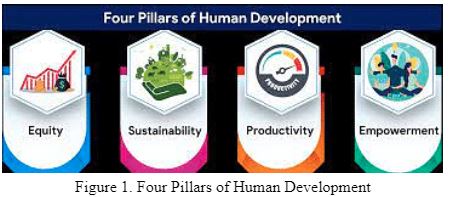


Instruction:
- There will be 2 questions carrying 10 marks each. Write your answers in 150 words
- Any page left blank in the answer-book must be crossed out clearly.
- Evaluated Copy will be re-uploaded on the same thread after 2 days of uploading the copy.
- Discussion of the question and one to one answer improvement session of evaluated copies will be conducted through Google Meet with concerned faculty. You will be informed via mail or SMS for the discussion.
Question #1. What is demographic transition? Explain its relevance with demographic changes.
Question #2. Discuss the goals set to achieve human development in Human Development Index.
(Examiner will pay special attention to the candidate's grasp of his/her material, its relevance to the subject chosen, and to his/ her ability to think constructively and to present his/her ideas concisely, logically and effectively).
STEPS & INSTRUCTIONS for uploading the answers
Step 1 - The Question for the day is provided below these instructions. It will be available at 7:00 AM.
Step 2 - Uploading of Answers : Write the answer in A4 Sheet leaving proper margins for comments and feedback and upload the PDF in MY ACCOUNT section. Click on the option of SUBMIT COPY to upload the PDF.
Step 3 - Deadline for Uploading Answers: The students shall upload their answers by 7:00 PM in the evening same day. The first 50 copies will be evaluated.
Step 4 - Feedback : Mentors will give their feedback for the answers uploaded. For more personalised feedback, join our telegram channel by clicking on the link https://t.me/mains_answer_writing_cse . A one-to-one session will be conducted with the faculty after copy evaluation in 72 Hrs.
Model Answer
Question #1. What is demographic transition? Explain its relevance with demographic changes.
Ans
The Demographic Transition Model was developed by the America demographer Warren Thompson in 1929. DTM depicts the demographic history of a country. It refers to the transition from high birth and high death rates to low birth and low death rates regime as a country develops from a pre-industrial to an industrialised economic system.
Demographic changes in a country have been observed passing through certain stages. It consists five stages of changes over a period of time as:
Stage 1 – Highly fluctuating Stage: its pre-industrial stage when both birth rate (BR) and death rate (DR) are high. High fluctuation in population is observed due to severe famine, diseases, wars and traditional methods of curing at time of famine and outbreak of any disease. It caused high death rate, high infant mortality rate and low life expectancy. The economic base of the society depends upon subsistence agriculture methods which gives low yield.
Countries or regions which has primitive society like tribes in Amazon basin and Congo basin belong to this stage of demographic transition. Human population up to 18th century was believed to be in this stage (fig.1).
Stage 2 – Rapid Increase: it is early expanding phase which has been influenced by industrial revolution. In this stage death rate fall sharply due to improvements in health care facilities and improved sanitation. Because of it birth rate remains high due to less awareness of people towards population control. It at last ended with high growth of total population.
Start of industrial revolution introduced improved technology in farming sector and also increase in food supply. So that health and nutrition issues had been solved in order to reach better health. People have been made accessible to water supply, better sanitation, and improvement in public health system.
Countries like Afghanistan, Pakistan, Sub-saharan countries and some West Asian countries belong to this stage in present time of 21st century (fig. 1).
Stage 3 – Late Expanding Stage: it is post-industrial revolution stage. In this stage birth rate fall rapidly due to awareness about population control (contraceptives). Death rate continues low due to improved health facilities. But total population keep rising and population gap becomes marginally narrower.
Countries who have made successful attempts to growth and development have entered in this stage like Costa Rica, Panama, Jamaica, Mexico, Colombia, Ecuador, Philippines, Indonesia, Malaysia, Sri Lanka, Turkey, Azerbaijan, Turkmenistan, Uzbekistan, Egypt, Tunisia, Algeria, Morocco, Lebanon, South Africa, India (fig. 1). Stage 4 – Low Stationary Stage: it is more or less stabilization or low stationary with very slow increase stage. In this stage birth control is widely observed because desire for smaller size of family. Therefore, both birth rate takes deep dip and death rate have also been observed low but total population remains high due to share of youth population who are educated and aware about demerits of high population.
Industrialised nations like South Korea and Taiwan have recently joined this stage. Unites States, Canada, Australia, New Zealand and most of European countries come in this stage (fig. 1)
Stage 5 – Declining Population Stage: In this stage birth rate goes to negative rate. Aged population becomes bigger size in demographic structure and total growth rate of population also recorded negative. Therefore, population declines gradually because of negative growth. This stage witnesses modern social structure and lifestyle so that it creates different types of diseases like mental stress and diabetes.
Countries like Germany, Italy, Japan and Russia belong to this stage of demographic transition which reports about shrinking population (fig. 1).
Conclusion
Demographic change always put negative and positive impacts on nation’s economy. India is one of country in world who has been using it as human resource.
Question #2. Discuss the goals set to achieve human development in Human Development Index.
Ans
The concept of human development was introduced by Pakistani economist Dr Mahbub-ul-Haq in 1990. As devised by Dr. Haq, Human Development Index (HDI) is indicator of human development which enlarges people’s choices and improves their lives. People are central to all development under this concept. People’s choices keep changing over the period of time. The ultimate objectives of development is to develop conditions where people can live better lives. The better life does not mean long years rather it means a qualitative and healthy life.
Goals (pillars) of Human Development
The human development goals also known as pillars of human development. These goals consist:
- equity
- sustainability
- productivity
- empowerment.
Equity means providing equal access to opportunities to everybody. The opportunities should be provided to people equally irrespective of their gender, race, income and irrespective of caste also. Yet this is very often not the case and happens in almost every society.
For example, in western countries black skin people have been discriminated. In case of India, large number of women and socially and economically backward groups have been discriminated. They have not been given equal opportunities. They remain inaccessible to opportunities and limited access to knowledge.
Sustainability stands for continuity in the availability of opportunities. To have sustainable human development, each generation must have the same opportunities. All environmental, financial and human resources must be used keeping in mind the future and future generations. Any mismanagement and misuse of resources will lead to reduced opportunities for future generations.
Best example can be cited that sending girls to school is very much essential otherwise they will mis many opportunities in future and they would not able to grow in life. Their ability to grow in life would be limited or absent. Therefore, it must be made ensure to provide opportunities to all irrespective of gender.
Productivity means human labour productivity or productivity in terms of human work. Every individual should have equal opportunities to enhance their productivity and capabilities which would lead to better work efficiency. If people enhance their productivity then they can be considered and used as assets for nation.
Empowerment means to enhance capabilities to increase choices for growth. The empowerment comes when an individual has complete freedom and capability. This can be achieved by good governance and people-oriented policies which ensure complete empowerment and overall growth of people. The empowerment is more focussed on socially and economically disadvantaged groups.
Conclusion
Human Development Index (HDI) is motivated toward welfare of society and ensuring equality of all sections of society. Serious attention and execution of goals of HDI shall make country to achieve sustainable and equal growth of society.



